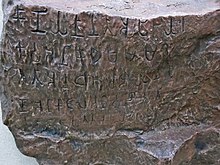Old Tamil: Difference between revisions
DerekWinters (talk | contribs) No edit summary |
DerekWinters (talk | contribs) No edit summary |
||
| Line 34: | Line 34: | ||
==References== |
==References== |
||
{{reflist|30em}} |
{{reflist|30em}} |
||
[[Category:Tamil language]] |
|||
[[Category:Dravidian languages]] |
|||
[[Category:Ancient languages]] |
|||
Revision as of 02:10, 29 June 2015
| Old Tamil | |
|---|---|
| Era | Developed into Middle Tamil by the 8th century |
| Tamil-Brahmi, later Vaṭṭeḻuttu and the Pallava alphabet | |
| Language codes | |
| ISO 639-3 | oty |
oty Old Tamil | |
| Glottolog | oldt1248 Old Tamil |

Old Tamil is the period of the Tamil language spanning the 5th century BCE to the 8th century CE.
The earliest records in Old Tamil are short inscriptions from between the 5th and 2nd century BCE in caves and on pottery. These inscriptions are written in a variant of the Brahmi script called Tamil Brahmi.[1] The earliest long text in Old Tamil is the Tolkāppiyam, an early work on Tamil grammar and poetics, whose oldest layers could be as old as the 1st century BC.[2] A large number of literary works in Old Tamil have also survived. These include a corpus of 2,381 poems collectively known as Sangam literature. These poems are usually dated to between the 1st and 5th centuries AD,[2][3] which makes them the oldest extant body of secular literature in India.[4] Other literary works in Old Tamil include Thirukural, Silappatikaram and Maṇimēkalai, and a number of ethical and didactic texts, written between the 5th and 8th centuries.[2]
Old Tamil preserved many features of Proto-Dravidian, including the inventory of consonants,[5] the syllable structure,[6] and various grammatical features.[7] Amongst these was the absence of a distinct present tense – like Proto-Dravidian, Old Tamil only had two tenses, the past and the "non-past". Old Tamil verbs also had a distinct negative conjugation (e.g. kāṇēṉ (காணேன்) "I do not see", kāṇōm (காணோம் "we do not see")[8] Nouns could take pronominal suffixes like verbs to express ideas: e.g. peṇṭirēm (பெண்டிரேம்) "we are women" formed from peṇṭir (பெண்டிர்) "women" and the first person plural marker -ēm (ஏம்).[9]
Despite the significant amount of grammatical and syntactical change between Old, Middle and Modern Tamil, Tamil demonstrates grammatical continuity across these stages: many characteristics of the later stages of the language have their roots in features of Old Tamil.[2]
References
- ^ Mahadevan 2003, pp. 90–95
- ^ a b c d Lehmann 1998, pp. 75–76
- ^ The dating of Sangam literature and the identification of its language with Old Tamil have recently been questioned by Herman Tieken who argues that the works are better understood as 9th century Pāṇṭiyan dynasty compositions, deliberately written in an archaising style to make them seem older than they were (Tieken 2001). Tieken's dating has, however, been criticised by reviewers of his work. See e.g.
- Attention: This template ({{cite doi}}) is deprecated. To cite the publication identified by doi:10.2307/4132191, please use {{cite journal}} (if it was published in a bona fide academic journal, otherwise {{cite report}} with
|doi=10.2307/4132191instead. - Attention: This template ({{cite doi}}) is deprecated. To cite the publication identified by doi:10.2307/1179075, please use {{cite journal}} (if it was published in a bona fide academic journal, otherwise {{cite report}} with
|doi=10.2307/1179075instead. - Attention: This template ({{cite doi}}) is deprecated. To cite the publication identified by doi:10.2307/3096501, please use {{cite journal}} (if it was published in a bona fide academic journal, otherwise {{cite report}} with
|doi=10.2307/3096501instead. - Attention: This template ({{cite doi}}) is deprecated. To cite the publication identified by doi:10.1553/wzksXLVIs105, please use {{cite journal}} (if it was published in a bona fide academic journal, otherwise {{cite report}} with
|doi=10.1553/wzksXLVIs105instead.
- Attention: This template ({{cite doi}}) is deprecated. To cite the publication identified by doi:10.2307/4132191, please use {{cite journal}} (if it was published in a bona fide academic journal, otherwise {{cite report}} with
- ^ Tharu & Lalita 1991, p. 70
- ^ Krishnamurti 2003, p. 53
- ^ Krishnamurti 2003, p. 92
- ^ Krishnamurti 2003, pp. 182–193
- ^ Steever 1998, p. 24
- ^ Lehmann 1998, p. 80
